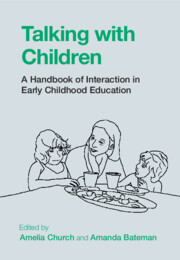Book contents
- Talking with Children
- Talking with Children
- Copyright page
- Dedication
- Contents
- Figures
- Tables
- Contributors
- Acknowledgements
- Notes on Transcription Conventions
- Introduction
- Part I Talk as Social Action
- 1 Conversation Analysis for Early Childhood Teachers
- 2 Sequences
- 3 Participation
- 4 Embodiment
- 5 Emotion
- 6 Socialization
- 7 Epistemics
- Part II Pedagogy in Interaction
- Part III Interaction and Inclusion
- Index
- References
3 - Participation
from Part I - Talk as Social Action
Published online by Cambridge University Press: 16 June 2022
- Talking with Children
- Talking with Children
- Copyright page
- Dedication
- Contents
- Figures
- Tables
- Contributors
- Acknowledgements
- Notes on Transcription Conventions
- Introduction
- Part I Talk as Social Action
- 1 Conversation Analysis for Early Childhood Teachers
- 2 Sequences
- 3 Participation
- 4 Embodiment
- 5 Emotion
- 6 Socialization
- 7 Epistemics
- Part II Pedagogy in Interaction
- Part III Interaction and Inclusion
- Index
- References
Summary
Early years teaching programs at undergraduate level introduce student teachers to sociocultural theorists such as Vygotsky, Bruner and Rogoff. Situating teaching techniques within these theoretical perspectives encourages student teachers to work with children within the metaphor of a ‘zone of proximal development’ (Vygotsky) to ‘scaffold’ (Bruner) children from one level of knowledge to the next through ‘guided participation’ (Rogoff). Understanding pedagogical interaction as a social and collaborative event between teacher and child is fundamental, but these metaphors can be challenging – particularly for pre-service teachers – in the practical implementation of early years curricula frameworks. Excerpts of real-life everyday interactions between teachers and young children explored using conversation analysis can demonstrate what the role of the early years teacher might look like when participating in a ‘zone of proximal development’ with children. The skilful ways in which teachers ‘scaffold’ learning with children through ‘guided participation’ in verbal and non-verbal turn taking will then be demonstrated. Through this exploration, the chapter brings together contemporary socio-cultural approaches to early years teaching and ethnomethodology’s concern with the practical achievement of participation to explain how participation frameworks provide a useful lens for understanding pedagogical interaction between children and teachers.
Keywords
- Type
- Chapter
- Information
- Talking with ChildrenA Handbook of Interaction in Early Childhood Education, pp. 55 - 77Publisher: Cambridge University PressPrint publication year: 2022
References
- 1
- Cited by



